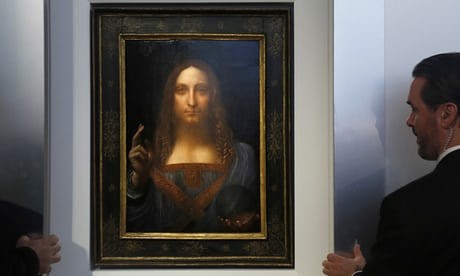The Salvator Mundi. Leonardo painted the orb as if it were a hollow glass bubble that does not refract or distort the light passing through it, one scholar notes. Photograph: AP
But other leading scholars have doubts. Frank Zöllner, of the University of Leipzig, wrote in an art journal in 2013 that the painting could be a “high-quality product of Leonardo’s workshop” or even a later follower.
Isaacson is particularly interested in research by Michael Daley, the director of ArtWatch UK, who said this week: “There isn’t enough to claim it’s a Leonardo. His figural development was towards greater naturalism and complexity of posture – heads turning this way, shoulders turning the other way, with twists and movement.
“The Salvator Mundi is dead-pan flat, like an icon, with no real depth in the modelling. Another unexplained peculiarity is that the figure itself is heavily and uncharacteristically cropped.”
Daley also pointed out that optical deflections appear in an engraving by Wenceslaus Hollar, the 17th-century etcher, from Leonardo’s original composition, dismissing the suggestion that “Leonardo knew all about the optics, but just decided not to bother”.
Isaacson said: “When you balance the evidence for and against … then that is a valid point, that Hollar would not have distorted the robes if they hadn’t been in the original painting … If you look at the Hollar engraving and, if it is much different, that counts against [this painting] being the original.”
In studying optics, he spoke to numerous science experts. Asked whether he would invest in the painting if he had $100m, Isaacson said: “The preponderance of the experts is that it is authentic, and so I would – but that doesn’t mean that I’d be absolutely sure.”
A Christie’s spokeswoman said: “Leonardo’s paintings are known for their mystery and ambiguity. He was intimately familiar with the technicality and qualities of optics and light. If he had recreated the image with optical exactitude, the background would have been distorted.
“It is our opinion that he chose not to portray it in this way because it would be too distracting to the subject of the painting.”
Paramount Pictures has bought the rights to Isaacson’s book and Leonardo DiCaprio plans to make a biopic inspired by it.
Since you’re here …
… we have a small favour to ask. More people are reading the Guardian than ever but advertising revenues across the media are falling fast. And unlike many news organisations, we haven’t put up a paywall – we want to keep our journalism as open as we can. So you can see why we need to ask for your help. The Guardian’s independent, investigative journalism takes a lot of time, money and hard work to produce. But we do it because we believe our perspective matters – because it might well be your perspective, too.
I appreciate there not being a paywall: it is more democratic for the media to be available for all and not a commodity to be purchased by a few. I’m happy to make a contribution so others with less means still have access to information. Thomasine F-R.

